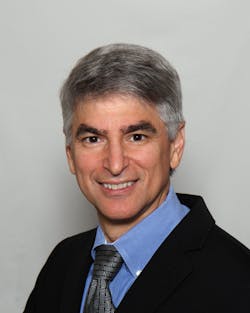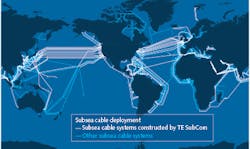
OSA: What is the role of submarine fiber optics?
Neal Bergano: Undersea fiber-optic cables enable a connected world and make the Web worldwide. We may think of the Internet as an abstract thing, but the Internet is built on the physical layer of fiber optics and high-speed integrated circuits.
OSA: How did you get involved?
NB: Peter Runge and Dave Ross hired me in 1981 at Bell Labs into a group developing fiber optics as the next technology for transoceanic cables. The state-of-the-art then was analog coaxial cable, which could carry a few thousand 3 kHz voice circuits, but could not scale further. We had a lot to learn. We didn't know if low-loss fibers could be made strong enough to withstand the strain of a cable being laid on the sea bottom and being recovered for repairs.
Undersea fiber cables became a huge paradigm shift. The first transatlantic fiber cable, TAT-8, had only about a factor of five more capacity than the last coaxial cable, but digital fiber transmission enormously improved the quality of a phone call. Overseas calls on analog coaxial cables were noisy and could have echoes. Satellite calls were delayed.
I knew what to expect, but I was still surprised by how good my first call over TAT-8 sounded. A guy I was working with called me from Britain the night before Isaac Asimov made the "first call" on the system, and said "no matter what you hear on television tomorrow, these are the first calls going over the cable."
OSA: How did capacity increase?
NB: Those first digital fiber systems were hybrid systems with electro-optical repeaters. The repeater converted the high-speed optical signal into electrical form and processed it in integrated circuits to drive a laser transmitter. That bottleneck limited fiber capacity.
The paradigm shift that expanded capacity was the erbium-doped fiber amplifier. I got in on the ground floor by setting up a lab to play with amplifiers in the late 1980s. We had a huge chicken-and-egg problem. You could never build a full-length transmission experiment without a huge development program, but you needed a validation experiment to justify a development program. That led us to invent the circulating loop testbed. We concatenated fibers and optical amplifiers to make a modest amplifier chain, and sent signals through that 120 km loop again and again to emulate transoceanic transmission. We discovered all kinds of interesting things with that system.
We tried to demonstrate transoceanic transmission of a 5 Gbit/s signal at low error rate. It seems trivial today, but then it wasn't. Sometimes I wish my future self could have gone back and told my past self a few things that would have saved me years. We did some ideas all wrong, like tuning signals to have zero chromatic dispersion. Eventually, our Bell Labs colleagues helped us figure out that nonlinear interactions made zero dispersion a bad thing.
OSA: When did wavelength-division multiplexing come in?
NB: As soon as we got a single channel working, we started playing with WDM. Our first WDM test was only four channels, each at 2.5 Gbits for a total of 10 Gbits. When we realized that channels interacted, we added dispersion management. New transmission formats helped us increase higher data rates. We did some of the first experiments on forward error correction. Those were exciting and frustrating times with very long hours. I joke that I wandered into the lab one day and walked out seven or eight years later.
The introduction of a practical coherent transponder was the third basic paradigm shift. Originally, direct detection just turned a light on for one and off for zero, on-off keying up to billions of times a second. Coherent detection was tried in the early 1980s, but it didn't work because we couldn't lock the local oscillator to the signal frequency. Now, we get the two frequencies just close enough that fast sampling and digital signal processors (DSPs) can track the phase digitally and unscramble everything.
OSA: What's the capacity of today's transatlantic systems?
NB: In round numbers, each fiber pair contains 100 WDM channels each carrying a 100 Gbit/s coherent signal, or 10 Tbit/s. A typical transatlantic cable can hold up to eight fiber pairs, so it can carry 80 Tbit/s. That is seven orders of magnitude larger than the capacity of the first submarine telephone cable that went into service 60 years ago. Many of our submarine systems are undersea networks running parallel to continental coastlines, with add/drop cables connecting to onshore locations (see figure). Because each fiber pair has huge capacity, it makes sense for users to share that capacity, as in terrestrial networks.We use large-effective-area fibers with very low loss, the highest-performing type available. They have a lot of chromatic dispersion, but with coherent transponders the DSPs can do the dispersion compensation digitally. The high dispersion also keeps channels from interacting with each other, improving transmission quality.
OSA: What is the role of fiber in our increasingly mobile world?
NB: We always think of cell phones as wireless communications devices. But 99% of the distance the signal travels between phones is on fiber-optic cable. Wireless transmission is only for a mile or two to the cellphone tower; then, fiber carries it the rest of the way. So the entire wireless system is built on fiber optics. The mobile network is a misnomer—users are mobile, but cell sites and cables are fixed.
OSA: Where do we go from here?
NB: We are getting within factors of five or six of the fundamental Shannon limit on capacity of a single fiber mode. But good engineering will grow capacity because that limit is spectral efficiency-defined in bits per second per hertz of optical bandwidth. So we can increase capacity by using more optical bandwidth.
Other techniques can increase cable capacity by orders of magnitude. Capacity will scale with the number of modes you can get into a core, the number of cores in a fiber, and the number of fibers in a cable. That's because the Shannon limit is for a single mode, not a fiber or cable. So I remain a complete optimist. We won't be breaking any fundamental laws of nature, but we don't need to.
When I talk about the future, I think of when we celebrated the 35th service anniversary of a colleague last year. We started together and now that I'm the CTO, they invited me for cake and coffee. When it came time for me to say something, I recalled that another guy in the room had started that week. So I turned to the new guy and said, "I wonder what a communication system will look like when you celebrate your 35th anniversary in the year 2050." Imagine a multimode fiber with a coherent image processor, and every pixel in the image plane being a receiver. It sounds impossible today, but that will change when someone figures out how to do it.
Neal Bergano is vice president and chief technology officer at TE Connectivity SubCom, which has supplied well over 500,000 km of submarine fiber-optic cable. Trained in electrical engineering and optics, he joined the Bell Labs group developing the first transoceanic fiber-optic cable in 1981, and spent his entire career on submarine optical systems. He is a fellow of IEEE, OSA, AT&T, and TE Connectivity, and the recipient of the 2002 John Tyndall Award.
The Optical Society celebrates a century of innovation
Throughout a century of breakthroughs, The Optical Society has brought together the best minds in optics and photonics to light the future. This series reflects on that history and looks to what innovations lie ahead. For more information, please visit http://osa.org/100.
